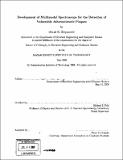| dc.contributor.advisor | Michael S. Feld. | en_US |
| dc.contributor.author | Šćepanović, Obrad R., 1980- | en_US |
| dc.contributor.other | Massachusetts Institute of Technology. Dept. of Electrical Engineering and Computer Science. | en_US |
| dc.date.accessioned | 2009-03-16T19:32:34Z | |
| dc.date.available | 2009-03-16T19:32:34Z | |
| dc.date.copyright | 2008 | en_US |
| dc.date.issued | 2008 | en_US |
| dc.identifier.uri | http://hdl.handle.net/1721.1/44709 | |
| dc.description | Thesis (Ph. D.)--Massachusetts Institute of Technology, Dept. of Electrical Engineering and Computer Science, 2008. | en_US |
| dc.description | Includes bibliographical references (p. 205-228). | en_US |
| dc.description.abstract | The combination of reflectance, fluorescence, and Raman spectroscopy - which is termed multimodal spectroscopy (MMS) - provides complementary and depth-sensitive information about tissue composition. As such, MMS can provide biochemical and morphological information useful in detecting vulnerable atherosclerotic plaques, that is, plaques most prone to rupture and causing sudden death. Early detection of these vulnerable plaques is critical to reducing patient mortality associated with cardiovascular disease. In developing MMS into a clinical diagnostic modality, several scientific and engineering directions are explored in this work: the physical motivation for MMS, the framework of quantitative extraction of spectral parameters, the spectral probes that enable the efficient collection of data, a clinical instrument able to provide real-time diagnosis, and, finally, a clinical implementation of the entire methodology. The motivation for MMS is shown through a pilot in vitro study using carotid artery specimens, which shows the promise for MMS to detect features of vulnerable plaque. Having established the motivation, the next step describes the mathematical tools used to extract quantitative spectral parameters and, moreover, to assess the uncertainty and confidence of the spectral information. In order to implement MMS, the development of an efficient, specialized MMS probe for data acquisition and a compact and practical clinical MMS instrument are described. Lastly, in vivo and ex vivo results from a relatively large clinical study of vulnerable plaque in humans show excellent agreement between MMS and histopathology. Specifically, MMS is shown to have the ability to detect a thin fibrous cap, necrotic core or superficial foam cells, and thrombus. | en_US |
| dc.description.abstract | (cont.) In addition, these studies show that vulnerable plaques could be detected with a cross validated sensitivity of 89-96%, specificity of 72-78%, and a negative predictive value of 89-97%. These very encouraging results serve as an important step in bringing MMS into the clinical arena as a powerful diagnostic technique. | en_US |
| dc.description.statementofresponsibility | by Obrad R. Šćepanović. | en_US |
| dc.format.extent | 228 p. | en_US |
| dc.language.iso | eng | en_US |
| dc.publisher | Massachusetts Institute of Technology | en_US |
| dc.rights | M.I.T. theses are protected by
copyright. They may be viewed from this source for any purpose, but
reproduction or distribution in any format is prohibited without written
permission. See provided URL for inquiries about permission. | en_US |
| dc.rights.uri | http://dspace.mit.edu/handle/1721.1/7582 | en_US |
| dc.subject | Electrical Engineering and Computer Science. | en_US |
| dc.title | Development of multimodal spectroscopy for the detection of vulnerable atherosclerotic plaques | en_US |
| dc.title.alternative | Development of MMS for the detection of vulnerable atherosclerotic plaques | en_US |
| dc.type | Thesis | en_US |
| dc.description.degree | Ph.D. | en_US |
| dc.contributor.department | Massachusetts Institute of Technology. Department of Electrical Engineering and Computer Science | |
| dc.identifier.oclc | 297429369 | en_US |
